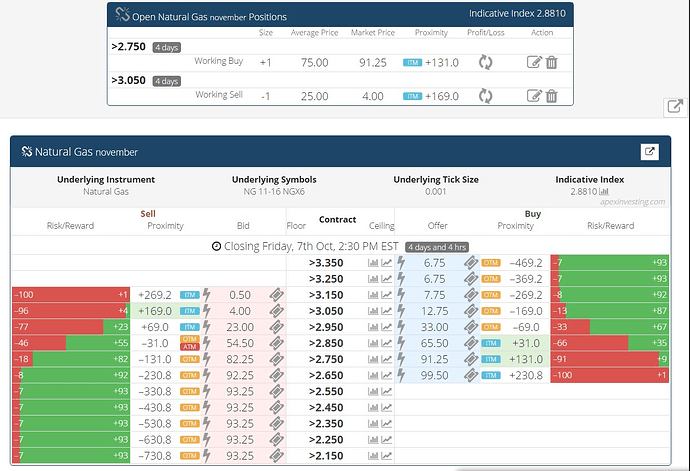By Darrell Martin
Mixing butterflies and natural gas may not sound like a good combination. However, when analyzing the natural gas chart shows it has been trading in a channel or has been range bound for a number of days, using a binary butterfly strategy may prove advantageous. Remember, the following is not a trade recommendation, but is for educational purposes only.
Every Thursday, at 10:30 AM ET, the Energy Information Administration (EIA) for the United States releases the Natural Gas Inventory Report. Since Natural Gas has been trading in a channel lately, simply define the top and bottom of the channel to determine the range of the trade.
As a reference for this article, please note that the chart for Natural Gas showed the market settled at 3.050 on September 27, but has not returned to that level. The market hit its lowest point in recent times, 2.866 on October 3, and then settled at 2.923. October 4 brought more of the same, with the market staying between the low of 2.87 and the high of 2.991 before settling at 2.964. By looking at these numbers, the range could be determined to be between 2.86 and 3.05.
The binary butterfly strategy is set up using Nadex Binary Options, buying a lower contract and, if possible, simultaneously selling an upper contract. The lower contract will be slightly below the bottom of the range while the upper contract will be slightly above the top of the range. This gives the trade some wiggle room.
Knowing that the Natural Gas Inventory Report is released every Thursday, if the trend persists and the market continues to be range bound, this could become a strategy to consider weekly. To take full advantage of it, consult the Natural Gas charts as early in the week as possible, over the weekend or as the markets open for the week. Establish if the market is trending or range-bound. If range-bound, figure out the range. To have the best probability for profitability on this trade, look at the weekly contracts expiring Friday, at 2:30 PM ET. Consider what binary strike price the market will possibly be above, and what binary strike price the market will possibly be below. This is how to figure the range.
Since this trade is based on using Nadex Binary Options, once the range is calculated, log in to Nadex. To further simplify placing this trade, use the Apex Binary scanner, which is available free for all traders to use. The Apex scanner is shown below.
Notice the available strike prices of 2.850 and 2.750 for Nadex binaries that are offered for the lower buy side of the trade. As stated earlier, 2.750 will give the trade more wiggle room. Pull up a ticket and enter the suggested buy price for this side of the trade, which is $75.
Again, looking at the image below and remembering the range, notice the available strike prices. The upper range is 3.05, so using that strike, pull up a ticket and enter the suggested price of $25. Both of these orders will go into working orders because the current bid (sell) and offer (buy) prices have not reached the requested prices of $75 and $25 entered when the order was placed. The market must oscillate to have the orders filled, so they will probably not be filled at the same time. See listing under “Market Price” for the current prices below.
Here is the important learning point. If the orders are filled, the potential profit on the bought contract is $25. The most that can be made on the sold contract is $25. Max loss is $75 on each side. While this seems like a bad risk/reward ratio, when both sides of the butterfly are put together, the market cannot settle both above 3.050 and below 2.750 at the same time. As long as both sides fill and the trade is left untouched, one side will profit. Profit will be $25. If both contracts fill and the market stays in the range as of expiration, profit will be $50. However, there is the potential loss of $75 on the other side, if it doesn’t stay in the range. The worst-case scenario is a loss of $50.
Remember, the one price that can always be counted on when trading binaries is the mid-price. For example, let’s say the 2.750 contract is filled. If the market drops down and hits 2.750, at that point, the contract will be worth around $50. Apex Investing’s free scanners offer a stop trigger, which can be automatically set to exit the trade once the market hits the strike price. The trade would then have a $25 loss instead of $75. Don’t just hold it and see what happens.
In summary, if the market is range-bound, this is a potential weekly trading opportunity. Place the trade Monday morning before work, or any time early in the week. Do not force the trade. Do not take a closer strike just to have the order filled. Allow the market to oscillate to give the trade the best probability.
To acquire a free trading education and use the free scanners, visit Apex Investing.

